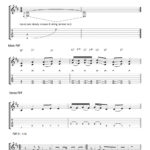Learning to tune your bass guitar is a foundational skill for any aspiring bassist. An out-of-tune bass, no matter how well played, will always sound off. Consistent practice is key to mastering any instrument, and ensuring your 5 String Bass Guitar Tuning is accurate makes practice sessions far more enjoyable and productive. Especially when you are jamming with others, proper tuning is non-negotiable. Luckily, tuning your bass, particularly with modern tools, is easier and more reliable than ever before.
Understanding Bass Tuning Basics
Before diving into the specifics of 5 string bass guitar tuning, let’s cover the fundamental components involved in tuning. The tuning pegs, located on the headstock of your bass, are the control centers for pitch adjustment. By turning these pegs, you manipulate the tension of the strings, thereby altering their pitch. Tightening a string increases its pitch, making it sharper, while loosening it lowers the pitch, making it flatter.
How Often Should You Tune Your 5 String Bass?
Regular tuning is not just recommended; it’s essential. Ideally, you should tune your 5 string bass every single time you pick it up to play. While basses generally hold their tune better than standard guitars due to the heavier gauge of strings, they are still susceptible to going out of tune due to temperature changes, humidity, and even just the act of playing.
If your bass doesn’t sound quite right when you’re practicing, or if it sounds dissonant when playing along with recordings, the first thing you should do is check your tuning. Accurate 5 string bass guitar tuning is the bedrock of good sound.
 Close up of bass guitar headstock with tuning pegs
Close up of bass guitar headstock with tuning pegs
Methods for Tuning Your 5 String Bass Guitar
There are two primary methods for achieving accurate 5 string bass guitar tuning:
- Tuning by Ear Using a Reference Note: This traditional method involves using a “reference note” from a reliable source such as another instrument (like a piano), a tuning fork, or a pitch pipe. You then adjust your bass strings to match this reference pitch by ear.
- Utilizing Electronic or Clip-on Tuners: Modern technology offers electronic tuners, particularly clip-on tuners, which have significantly simplified the tuning process. These devices attach directly to your bass’s headstock and detect string vibrations to indicate whether your notes are flat (too low), sharp (too high), or perfectly in tune.
Tuning with a Clip-On Electric Tuner
Clip-on tuners are a game-changer for 5 string bass guitar tuning. Unlike older electronic tuners that required plugging in, clip-on tuners are incredibly convenient and accurate. They sense vibrations directly from the headstock, providing real-time feedback on your tuning adjustments.
When selecting a clip-on tuner for your 5 string bass, ensure it is capable of accurately registering the low B string, which is the lowest note on a standard 5 string bass. Many modern tuners are designed to handle these lower frequencies effectively. These tuners are affordable, user-friendly, and provide consistent accuracy. Many bass practice amplifiers even come equipped with built-in tuners for added convenience.
Tuning Your 5 String Bass Without a Pitch Tuner
Even without a dedicated pitch tuner, you have several options for achieving accurate 5 string bass guitar tuning.
Using a Tuner App on Your Smartphone
The proliferation of smartphone apps has extended to musical instrument tuning. Numerous tuner apps are available for both iOS and Android devices, many of which are free. These apps utilize your device’s built-in microphone to detect the pitch of your bass strings. As you adjust your tuning pegs, the app’s display will guide you until you reach perfect tuning.
Tuning to a Reference Instrument
Another method is to tune your 5 string bass using a reference pitch from another instrument that you know is accurately tuned, such as a piano or a keyboard. This method requires a slightly more developed ear, as you must tune one of your bass strings to the reference pitch “by ear”.
The process involves playing the reference note, then playing the corresponding note on your bass, and carefully listening for any difference in pitch. Adjust your bass string until its pitch precisely matches the reference. Once you have one string accurately tuned, you can then tune the remaining strings of your 5 string bass relative to each other. This is done by fretting a note on a lower string and tuning the next open string to match that fretted note.
Exploring 5 String Bass Guitar Tuning
While 4-string basses in standard E-A-D-G tuning are incredibly common, 5 string basses offer an expanded tonal range, making them increasingly popular across various musical genres. There are a couple of common 5 string bass guitar tuning configurations.
Standard 5 String Bass Tuning: B-E-A-D-G
The most prevalent 5 string bass guitar tuning adds a low B string below the standard E string. This results in a tuning of B, E, A, D, G. This extends the lower range of the bass, providing deeper and richer tones, particularly beneficial in genres like metal, progressive rock, and jazz.
 Close up of bass guitar headstock with tuning pegs
Close up of bass guitar headstock with tuning pegs
The beauty of standard bass tuning, whether 4-string or 5-string, lies in its consistent intervals. Bass strings are generally tuned in fourths, meaning the interval between each string is a perfect fourth. This consistent tuning pattern simplifies learning scales, chords, and patterns across the fretboard.
Alternative 5 String Bass Tuning: E-A-D-G-C
Less common, but still utilized, is a 5 string bass guitar tuning that adds a high C string above the G string. This results in E, A, D, G, C. This configuration expands the higher register of the bass, offering brighter tones and facilitating melodic playing in higher octaves. While less frequently used than the low B configuration, it provides unique sonic possibilities.
For the vast majority of players exploring 5 string basses, the B-E-A-D-G tuning is the standard and most versatile choice. It provides the extended low end that is a primary reason for choosing a 5 string bass in the first place.
Maintaining Your 5 String Bass Guitar Tuning
Once you’ve achieved accurate 5 string bass guitar tuning, there are several proactive steps you can take to help your bass stay in tune for longer periods.
-
Regular String Changes: Bass strings, especially those on a 5 string bass due to the added low B string, can lose their vibrancy and tuning stability over time. When your strings start to sound dull or become difficult to keep in tune, it’s time for a string change. When installing new strings, remember to stretch them properly. Gently pull on the strings or play them in to accelerate the stretching process and improve tuning stability. Bass strings, being heavier gauge, generally last longer than guitar strings. However, for optimal tone and tuning, consider changing them every one to three months depending on your playing frequency and preferences.
-
Keep Your Bass Clean: Cleanliness is crucial for both string longevity and tuning stability. Always wash your hands before playing your 5 string bass. After each playing session, wipe down the strings with a clean, dry cloth to remove sweat, oils, and dirt. This simple habit can significantly extend the life of your strings and maintain consistent tuning.
-
Proper Bass Storage: Protect your 5 string bass from environmental factors. When not in use, store your bass in its case or gig bag. This shields it from dust, humidity fluctuations, and temperature changes, all of which can negatively impact tuning stability. Avoid leaving your bass in direct sunlight, extreme temperatures, or excessively humid environments.
By following these guidelines for 5 string bass guitar tuning and maintenance, you’ll ensure your instrument is always ready to play, sounds its best, and provides an enjoyable and rewarding playing experience.
Unleash Your Bass Potential with Expert Guidance
Now that you understand the intricacies of 5 string bass guitar tuning, you’re well-equipped to keep your instrument sounding its best. To truly elevate your bass playing, consider taking the next step and exploring comprehensive bass lessons. Whether you are a beginner just starting your bass journey or an experienced player looking to refine your skills, structured lessons can provide invaluable guidance. Unlock your inner bassist and embark on a path of musical growth and mastery!

